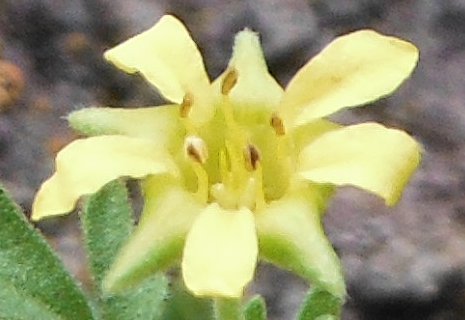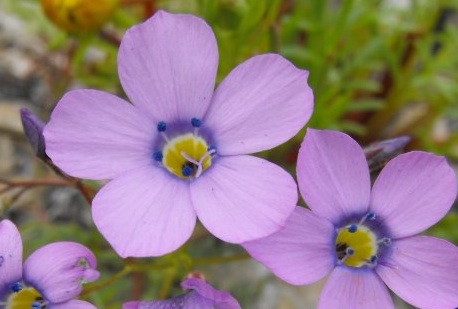|
|

|
Lesser Mohavea
January/February
Also known as Golden Desert Snapdragon, this neat little flower is found
throughout the Mojave Desert at elevations below 4600 feet. Generally found
in washes, this attractive wildflower blooms from late February through
April. Formerly classified as a member of the Figwort Family
(Scrophulariaceae), this plant is now considered to be a member of the
Plantain Family (Plantaginaceae) as a result of genetic analysis of its
genome.
(Click here for more info!)
|

|
Bailey's Ivesia
March/April
Some plants are difficult to identify and for some reason Bailey's Ivesia
gave me a particularly difficult time! I photographed this plant last summer
while on a hike in Nevada. In fact, it was in the Quinn Range, not far from
Adaven (that's Nevada spelled backwards, in case you didn't notice). The
plants were growing up on a rock wall, hanging out of crevices. They were
hard not to notice and since I was already out on a plant hunting
expedition, it stands to reason that I snapped some pictures. BTW, a similar
species called Rock Mousetail (Ivesia saxosa) is found in the Panamint
Range.
(Click here for more info!)
|

|
Gilia
May/June
Endemic to Calfornia, broad-flowered gilia is not only an attractive spring
wildflower, it is also likely to make a showing even during dry years. Also
known as hollyleaf gilia and by the scientific name Gilia latiflora, this
plant produces flowers during April, May, and June. It grows to a height of
up to about twelve inches and is most often found growing in washes.
(Click here for more info!)
|

|
Spectacle-Pod
July/August
Sometimes blooming in early February, Spectacle-Pod is an attractive plant
often found growing in and around sand dunes and sandy washes. This plant is
prevalent in Searles Valley and in many other locations in the Death Valley
region. As is typical of other members of the Mustard Family (Brassicaceae),
the flowers have four petals and six stamens. BTW, at one time the
Brassicaceae was known as the Cruciferae.
(Click here for more info!)
|

|
Dune Evening-Primrose
September/October
Also known as Birdcage Evening Primrose, Dune Primrose, and Desert Lantern,
this flower is especially prevalent in sand dune areas from Panamint Valley
to Indian Wells Valley at elevations between 1100 and 3500 feet. Although
most plant books state that this plant produces flowers from March through
May, some years flowers appear during the last half of February. As the name
suggests, this plant is found growing in and around sand dunes.
(Click here for more info!)
|

|
Ground Cherry
November/December
The flowers produced by Ground Cherry are quite attractive, but its fruit is
equally, if not more, interesting. Most often described as resembling a
paper lantern, it is no surprise that this plant is closely related to an
ornamental known as Chinese lantern (Physalis alkekengi). Enclosed in the
"paper lantern" is a fleshy berry, a feature shared with another relative, the
tomatillo (Physalis philadelphica). Although Ground Cherry produces a root
which is sometimes compared to that of a radish, it is in no way related to
the radish!
(Click here for more info!)
|
|
| |
|

blackturtle.us
PLANT
BLOG
BLOG INDEX
ASSOCIATED SITES:
Trona News
Rusky Ed
Any Place Education








|

















